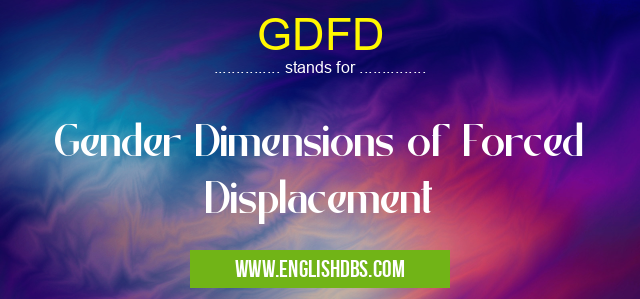What does GDFD mean in UNCLASSIFIED
GDFD stands for Gender Dimensions of Forced Displacement. It refers to the specific challenges and risks faced by individuals based on their gender identity, expression, or perceived gender due to forced displacement situations. This includes displacement due to conflict, persecution, natural disasters, or other forms of violence.

GDFD meaning in Unclassified in Miscellaneous
GDFD mostly used in an acronym Unclassified in Category Miscellaneous that means Gender Dimensions of Forced Displacement
Shorthand: GDFD,
Full Form: Gender Dimensions of Forced Displacement
For more information of "Gender Dimensions of Forced Displacement", see the section below.
GDFD Meaning
GDFD encompasses a range of issues that impact displaced individuals differently depending on their gender. These include:
- Protection concerns: Displaced women and girls are at increased risk of gender-based violence, sexual exploitation, and trafficking.
- Access to services: Gender norms and stereotypes can limit access to essential services, such as healthcare, education, and legal protection.
- Livelihoods and economic security: Women and girls may face barriers to employment and income-generating activities due to gender discrimination or caregiving responsibilities.
- Political participation: Displaced women and girls often have limited opportunities to participate in decision-making processes that affect their lives.
Importance of Addressing GDFD
Addressing GDFD is crucial for ensuring the protection and well-being of all displaced individuals. By understanding the gendered dimensions of forced displacement, humanitarian and development actors can develop tailored interventions that:
- Protect women and girls from violence and exploitation.
- Empower displaced individuals by providing access to services and opportunities.
- Promote gender equality and inclusion within displacement settings.
Essential Questions and Answers on Gender Dimensions of Forced Displacement in "MISCELLANEOUS»UNFILED"
What is GDFD (Gender Dimensions of Forced Displacement)?
GDFD refers to the unique gender-related experiences, challenges, and vulnerabilities faced by individuals and communities forced to flee their homes due to conflict, persecution, or natural disasters. It encompasses the exploration of gender-based violence, inequality, and empowerment in forced displacement contexts.
How does GDFD differ from general approaches to forced displacement?
GDFD emphasizes the distinct needs and experiences of women, girls, men, and boys in displacement. It acknowledges that gender dynamics shape access to resources, safety, and protection, and that addressing gender-specific issues is crucial for effective humanitarian assistance and durable solutions.
What are some key gender-based challenges in forced displacement?
Gender-based challenges in forced displacement include increased risk of sexual and gender-based violence, limited access to education and employment, difficulties in accessing essential services like healthcare and sanitation, and heightened vulnerability to exploitation and abuse.
How can GDFD inform humanitarian interventions?
GDFD provides guidance for humanitarian actors to design and implement gender-sensitive programs. It emphasizes the need for gender analysis, targeted interventions, capacity building for women's organizations, and accountability for addressing gender-based violence.
What are the benefits of considering GDFD in durable solutions?
Incorporating GDFD into durable solutions helps ensure that women and girls have equal opportunities to participate in and benefit from recovery and reconstruction processes. It promotes gender equality, reduces vulnerabilities, and contributes to sustainable development and peacebuilding.
Final Words: GDFD is a critical concept that highlights the unique challenges faced by individuals based on their gender during forced displacement. Addressing GDFD is essential for ensuring that humanitarian and development efforts effectively meet the needs of all displaced populations. By integrating gender-sensitive approaches into all aspects of displacement response, we can create more equitable and inclusive societies for all.
